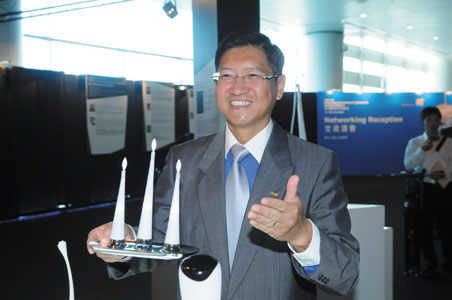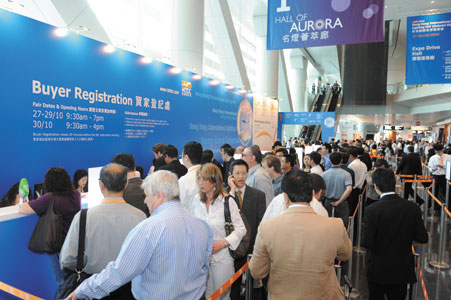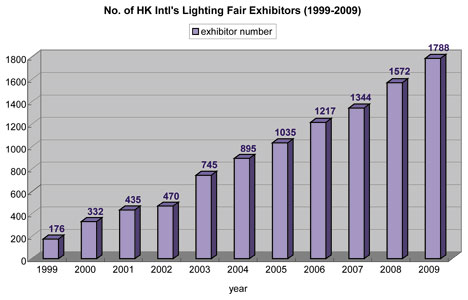Assistant Executive Director of HKTDC Raymond Yip Talks Shop
HK luckily has all three key
2010/01/13 | By Ken LiuFollowing the Gift and Premium Fair, Electronics Fair (Autumn edition) and Watch & Clock Fair, the International Lighting Fair (Autumn edition) has become another world-caliber trade show in Hong Kong, when the 2008 edition drew 1,572 exhibitors to outnumber the 1,500 lighting exhibitors at Ligh+Building in Frankfurt.

Contradicting conventional wisdom that the global recession would dampen trade shows, the HK lighting fair in 2009 attracted 1,788 exhibitors, the highest since the fair became an independent event, spun off from the electronics fair in 1999. Commenting on such success, Raymond Yip, Assistant Executive Director of the Hong Kong Trade Development Council (HKTDC), organizer of most of the trade fairs in the city, says that if the biennially held Light+Building in Frankfurt were rescheduled for this year, with rising lighting exhibitors, the German event would still be no match for the 2009 HK event's exhibitor number.

In an interview with the CENS Lighting Magazine, Raymond sheds light on the HKTDC's formula to achieve the lead in staging the Hong Kong lighting fair, gift fair, electronics fair and watch fair.

Q: What is the HKTDC's secret in building the Hong Kong lighting fair into a global leader?
A: You must have at least one of the three essential elements for successful trade fair with global presence. The first is to be in a manufacturing area. For instance, many significant trade fairs in Europe are in pivotal manufacturing areas where the showcased items are made. The second is to be close to a major market. For instance, many shows in the USA thrive on showing products that are consumed in huge numbers locally. The third is brand recognition carried by a city in which a trade show is held: For instance, Baselworld held in Switzerland is fittingly known for its horological industry, while the Nuremberg International Toy Fair also taps its traditional reputation as a hub for toy-making, which shows, although the city no longer produces toys, that reputation has historical value which may be commercialized.
Very Fortunate
Luckily, Hong Kong has all three ingredients: Hong Kong is amid the manufacturing complex developing on the Pearl River Delta, over which local entrepreneurs of various industries run over 50,000 factories employing some nine million workers, even far outnumbering the total population in HK.
As an added advantage, Hong Kong, after the Closer Economic Partnership Agreement (CEPA) took effect in 2003, exports goods to China duty-free.
Many of Hong Kong's trade fairs, such as the toy fair, have already built considerable brand recognition, with the watch and clock fair, gift fair, electronics fair and lighting fair having even become the world's No.1 in each category.
Q: How did Hong Kong become a global force in staging trade fair?
A: Hong Kong began organizing global trade fairs 40 years ago, making it a pioneer in the Asian trade fair industry. At that time, Hong Kong was still home to many factories, but our domestic market was tiny and the China market had yet to be liberalized. Our trade fair brand recognition took 40 years of diligence to build and the rest is history.
The HK trade fair development was put on the fast track in 1988 with the completion and unveiling of the phase I of the Hong Kong Convention and Exhibition Center, which then had 20,000 square meters of floor area, which was raised to 46,000 square meters in 1997 with phase II completed. The center now has 66,000 square meters with the latest expansion having been done in the first quarter of 2009; actually we can offer 99,000 square meters by including the parking lots, which can house booths for busy fairs. The gradual expansions reflect promise, that demand exceeds supply.
Q: What is HKTDC's role in Hong Kong's trade fair industry and what have been its achievements?
Early Start
A: Founded in 1966 by the Hong Kong government to specifically facilitate the city's international trade, the HKTDC originally focused on goods-trade promotion. In 1996, the center diversified to also promote service trades. Being a government institution, the HKTDC has the chairman of its board of directors be appointed by the Chief Executive of the Hong Kong Special Administrative Region Government, but the chairman and other 16 directors of the 19-seat board must be chairmen of various industrial associations, and only the remaining two directors are government officials. This means the board is dominated by business leaders to focus on business-oriented services.
To help Hong Kong's small and mid-sized businesses navigate through the recession, the council this year has allocated HK$120 million (about US$15 million) to finance their product promotions, and subsidize overseas buyers to come to trade fairs. Over 4,000 buyers in 69 trade missions from some 40 countries visited the lighting fair this year, compared with 3,500 buyers in 2008. They are professionals and these numbers do not include individuals.
In spite of official financing, we believe a good show is not built on government money. Business is fueled by a combination of sincere businesspeople and good exhibitors; while quality exhibitors go to a show for a productive trade environment not for availability of official financing. Hong Kong has all the right incentives for doing business, including being the world's freest economy, friendly to visitors, offering visa-free access to visitors from most countries, strictly ruled by law to offer complete legal protection to individuals and businesses, an English-speaking city, and within five-hour flying time for half of the world's population. Plus a buyer can conveniently go to a fair in the morning and still tour factories in the afternoon on the Pearl River Delta.
Q: Is the trade fair industry in HK treated differently by the colonial government and the current one in the SAR?
More Active
A: The British government mostly adopted the laissez-faire attitude towards the industry; but the SAR government is more active, setting aside HK$26 billion (about US$3.3 billion) to promote crucial events as logistics, hi-tech and cultural fairs. Besides, the SAR government has set up the Meeting & Exhibition Hong Kong Office under the Hong Kong Tourism Board to promote the city's tourism and exhibition activities overseas.
Q: How significant are the exhibition activities to Hong Kong's GDP?
A: The industry contributes about two-eighths to the Hong Kong annual GDP of around US$200 billion, excluding the revenue from orders placed during fairs. Actually, exhibition attendees have higher purchasing power than ordinary tourists. The government's statistics show each fair visitor spending an average of HK$6,000-7,000 (about US$779-909) per stay, but the council's numbers are higher.
Q: In recent years, the Hong Kong lighting fair has made major changes. This year, in particular, single-themed exhibitions of products as the Hall of LED Lighting and Hall of Aurora exclusively dedicated to brand-name exhibitors are notable. Also, the organizer began three years ago installing a zone showcasing lighting that are winners of design awards. So is the organizer trying to shake off its stereotypical image of being a club for OEMs and ODMs?
A: This is certainly one of the reasons. Besides hoping to develop this lighting fair into a one-stop-shop for buyers of OEM/ODM products, we also wish to satisfy buyers of brand-name and design-oriented products.
Another reason is to make procurement more convenient. Systematically grouping products by similar features enable buyers to quickly find what they want. After all, time is money, especially for businesspeople. Product classification is tedious, challenging work that enhances organizers' professionalism. Many organizers are self-centered when laying out exhibitions, forcing buyers to walk laboriously through many halls that may take a few days. But a typical international trade show is only three to four days; so a popular show is one that makes buyers' visit short and effective.




